拓扑绝缘体
- 格式:pdf
- 大小:2.93 MB
- 文档页数:14
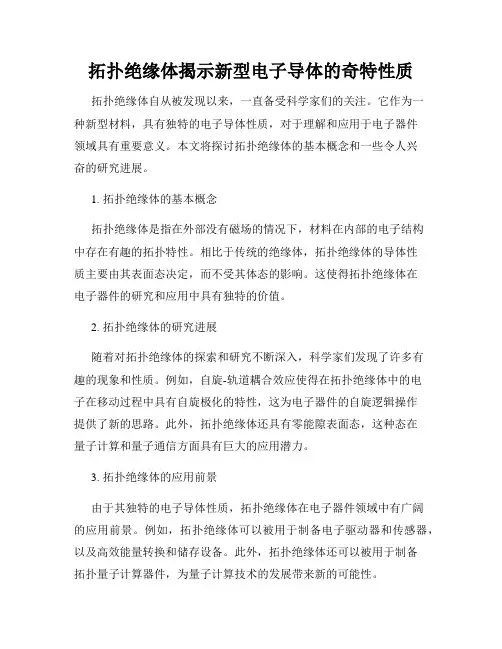
拓扑绝缘体揭示新型电子导体的奇特性质拓扑绝缘体自从被发现以来,一直备受科学家们的关注。
它作为一种新型材料,具有独特的电子导体性质,对于理解和应用于电子器件领域具有重要意义。
本文将探讨拓扑绝缘体的基本概念和一些令人兴奋的研究进展。
1. 拓扑绝缘体的基本概念拓扑绝缘体是指在外部没有磁场的情况下,材料在内部的电子结构中存在有趣的拓扑特性。
相比于传统的绝缘体,拓扑绝缘体的导体性质主要由其表面态决定,而不受其体态的影响。
这使得拓扑绝缘体在电子器件的研究和应用中具有独特的价值。
2. 拓扑绝缘体的研究进展随着对拓扑绝缘体的探索和研究不断深入,科学家们发现了许多有趣的现象和性质。
例如,自旋-轨道耦合效应使得在拓扑绝缘体中的电子在移动过程中具有自旋极化的特性,这为电子器件的自旋逻辑操作提供了新的思路。
此外,拓扑绝缘体还具有零能隙表面态,这种态在量子计算和量子通信方面具有巨大的应用潜力。
3. 拓扑绝缘体的应用前景由于其独特的电子导体性质,拓扑绝缘体在电子器件领域中有广阔的应用前景。
例如,拓扑绝缘体可以被用于制备电子驱动器和传感器,以及高效能量转换和储存设备。
此外,拓扑绝缘体还可以被用于制备拓扑量子计算器件,为量子计算技术的发展带来新的可能性。
4. 拓扑绝缘体的挑战与展望尽管拓扑绝缘体具有许多潜在的应用前景,但与此同时也面临着一些挑战。
拓扑绝缘体材料的制备和调控仍然存在一定的技术难题,需要更多的实验和理论研究来解决。
此外,拓扑绝缘体的性质和行为还需要进一步研究和理解,以实现其在电子器件领域的真正应用。
总结:拓扑绝缘体作为近年来兴起的新型材料,通过其独特的电子导体性质,揭示了新型电子导体的奇特性质。
随着对拓扑绝缘体的深入研究,我们对其基本概念和性质有了更深入的了解,并且发现了许多潜在的应用前景。
然而,要实现这些前景,我们仍然需要克服许多技术难题,并且深入研究和理解拓扑绝缘体的性质和行为。
相信在未来,拓扑绝缘体将成为电子器件领域的重要组成部分,并为我们带来更多的科学与技术突破。
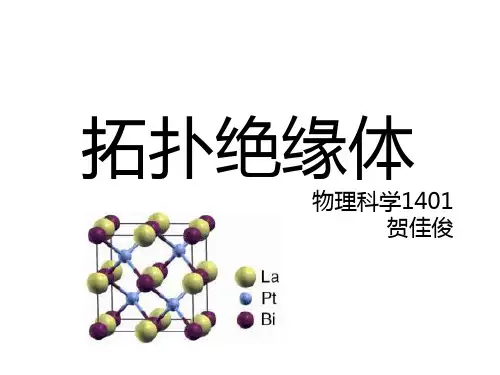
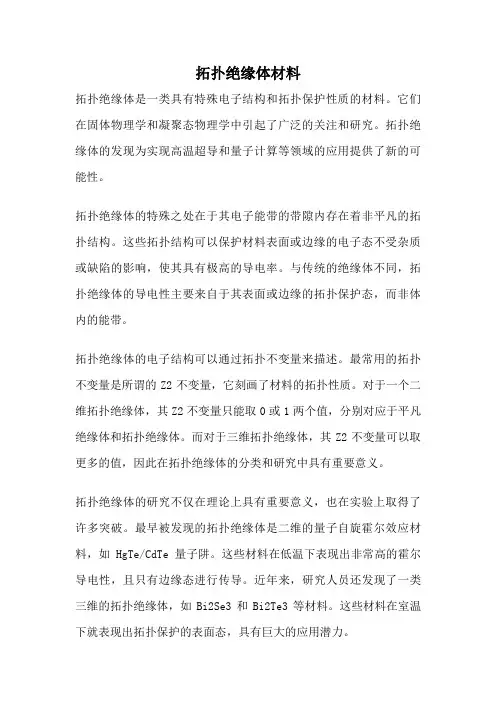
拓扑绝缘体材料拓扑绝缘体是一类具有特殊电子结构和拓扑保护性质的材料。
它们在固体物理学和凝聚态物理学中引起了广泛的关注和研究。
拓扑绝缘体的发现为实现高温超导和量子计算等领域的应用提供了新的可能性。
拓扑绝缘体的特殊之处在于其电子能带的带隙内存在着非平凡的拓扑结构。
这些拓扑结构可以保护材料表面或边缘的电子态不受杂质或缺陷的影响,使其具有极高的导电率。
与传统的绝缘体不同,拓扑绝缘体的导电性主要来自于其表面或边缘的拓扑保护态,而非体内的能带。
拓扑绝缘体的电子结构可以通过拓扑不变量来描述。
最常用的拓扑不变量是所谓的Z2不变量,它刻画了材料的拓扑性质。
对于一个二维拓扑绝缘体,其Z2不变量只能取0或1两个值,分别对应于平凡绝缘体和拓扑绝缘体。
而对于三维拓扑绝缘体,其Z2不变量可以取更多的值,因此在拓扑绝缘体的分类和研究中具有重要意义。
拓扑绝缘体的研究不仅在理论上具有重要意义,也在实验上取得了许多突破。
最早被发现的拓扑绝缘体是二维的量子自旋霍尔效应材料,如HgTe/CdTe量子阱。
这些材料在低温下表现出非常高的霍尔导电性,且只有边缘态进行传导。
近年来,研究人员还发现了一类三维的拓扑绝缘体,如Bi2Se3和Bi2Te3等材料。
这些材料在室温下就表现出拓扑保护的表面态,具有巨大的应用潜力。
拓扑绝缘体的发现引发了许多新的研究方向和领域。
一方面,科学家们希望进一步理解和揭示拓扑绝缘体的本质和特性。
另一方面,他们也在探索拓扑绝缘体的应用。
拓扑绝缘体的拓扑保护性质可用于实现高效的能量转换和传输,因此在能源领域具有重要意义。
此外,拓扑绝缘体还可以用于构建量子比特和实现量子计算,为量子信息领域带来了新的可能性。
虽然拓扑绝缘体在理论和实验上取得了一些重要进展,但仍然存在许多挑战和问题。
例如,如何制备高质量的拓扑绝缘体材料,以及如何有效地控制和调控其拓扑性质等。
这些问题需要在材料制备、表征和器件设计等方面进行深入的研究和探索。
拓扑绝缘体作为一类具有特殊电子结构和拓扑保护性质的材料,具有重要的科学意义和应用价值。
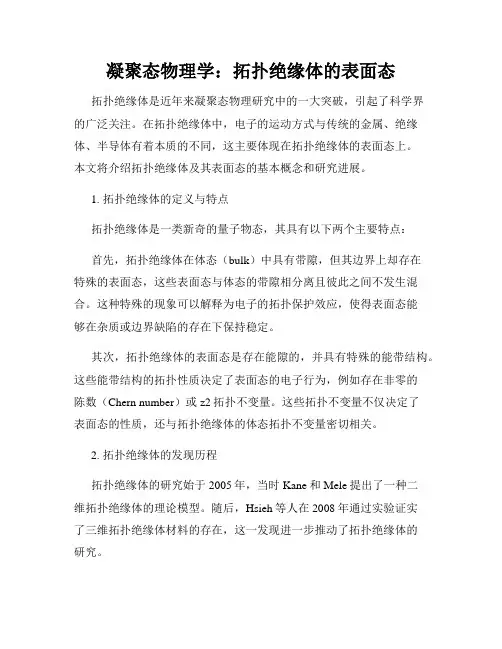
凝聚态物理学:拓扑绝缘体的表面态拓扑绝缘体是近年来凝聚态物理研究中的一大突破,引起了科学界的广泛关注。
在拓扑绝缘体中,电子的运动方式与传统的金属、绝缘体、半导体有着本质的不同,这主要体现在拓扑绝缘体的表面态上。
本文将介绍拓扑绝缘体及其表面态的基本概念和研究进展。
1. 拓扑绝缘体的定义与特点拓扑绝缘体是一类新奇的量子物态,其具有以下两个主要特点:首先,拓扑绝缘体在体态(bulk)中具有带隙,但其边界上却存在特殊的表面态,这些表面态与体态的带隙相分离且彼此之间不发生混合。
这种特殊的现象可以解释为电子的拓扑保护效应,使得表面态能够在杂质或边界缺陷的存在下保持稳定。
其次,拓扑绝缘体的表面态是存在能隙的,并具有特殊的能带结构。
这些能带结构的拓扑性质决定了表面态的电子行为,例如存在非零的陈数(Chern number)或z2拓扑不变量。
这些拓扑不变量不仅决定了表面态的性质,还与拓扑绝缘体的体态拓扑不变量密切相关。
2. 拓扑绝缘体的发现历程拓扑绝缘体的研究始于2005年,当时Kane和Mele提出了一种二维拓扑绝缘体的理论模型。
随后,Hsieh等人在2008年通过实验证实了三维拓扑绝缘体材料的存在,这一发现进一步推动了拓扑绝缘体的研究。
随着实验技术的不断发展,科学家们在拓扑绝缘体领域取得了诸多重要突破。
例如,通过陈数的计算和拓扑相变的实验证明了拓扑绝缘体的存在;借助扫描隧道显微镜、阿比尼奥等方法,科学家们成功地观测到了表面态的能带结构,揭示了其特殊的电子行为。
3. 拓扑绝缘体的应用前景由于其特殊的电子性质,拓扑绝缘体被认为是未来电子学、量子计算等领域的重要基础材料。
其表面态具有传导性,并且由于拓扑保护效应的存在,对杂质和缺陷具有一定的容错性。
这使得拓扑绝缘体在量子计算中具有很大的潜力,可以提高计算的稳定性和可靠性。
除了在量子计算中的应用,拓扑绝缘体还有其他多样且广泛的应用前景。
例如,拓扑绝缘体的表面态可以被用来实现高效率的能量转换,尤其是在热电材料领域;拓扑绝缘体还可以被应用于拓扑光学、拓扑超导等领域,为这些领域的研究和应用带来新的可能性。

拓扑绝缘体应用什么是拓扑绝缘体拓扑绝缘体是一种特殊的材料,其电子行为在能带拓扑结构中显示出来。
与普通绝缘体相比,拓扑绝缘体的电子行为更加奇特和稳定。
拓扑绝缘体具有一个带隙,在这个带隙中,电子不允许在材料内传导。
而在带隙的边界上,存在不可传递的表面态。
这些表面态是由于拓扑性质而产生的,它们具有较高的稳定性,并且能够抵抗外界干扰。
拓扑绝缘体的特性拓扑绝缘体具有许多独特的特性,使其在电子学、量子计算和能源等领域具有广泛的应用前景。
倒序型拓扑绝缘体倒序型拓扑绝缘体是一种拓扑电子态,在其材料内部的电子行为与外部世界的电子行为相反。
这种材料在正常条件下是绝缘体,只有在边界条件下才能够传导电子。
这种倒序型拓扑绝缘体的独特性质使其在电子学领域具有重要的应用潜力。
拓扑绝缘体的边界态拓扑绝缘体的边界态是其最重要的特性之一。
边界态是指拓扑绝缘体在边界上的电子态。
这些边界态在材料内部存在稳定且不能传导的电子行为。
拓扑绝缘体的边界态具有较高的稳定性和鲁棒性,使其在量子计算和信息存储等领域具有重要的应用价值。
拓扑绝缘体的独特电子输运性质拓扑绝缘体在电子输运方面具有独特的性质。
其输运性质与传统的金属、绝缘体和半导体有明显的区别。
拓扑绝缘体的导电性质主要由交叉边界态决定,而不是体态的电子行为。
这种独特的电子输运性质使得拓扑绝缘体在电子学领域具有巨大的应用潜力。
拓扑绝缘体的应用拓扑绝缘体的特殊性质赋予其在许多领域的广泛应用。
量子计算和信息存储拓扑绝缘体的边界态和独特的输运性质使其在量子计算和信息存储领域具有重要的应用价值。
通过利用边界态来实现量子纠缠和量子比特的储存和传输,可以大大提高量子计算和信息存储的效率和可靠性。
新型电容器和电池拓扑绝缘体的结构和电子性质使其在新型电容器和电池领域具有潜在的应用价值。
通过利用拓扑绝缘体的表面态来改善电容器和电池的储能能力和循环寿命,可以提高电子设备的性能和可靠性。
稳定的电子传输通道拓扑绝缘体的边界态具有较高的稳定性,可以作为稳定的电子传输通道。
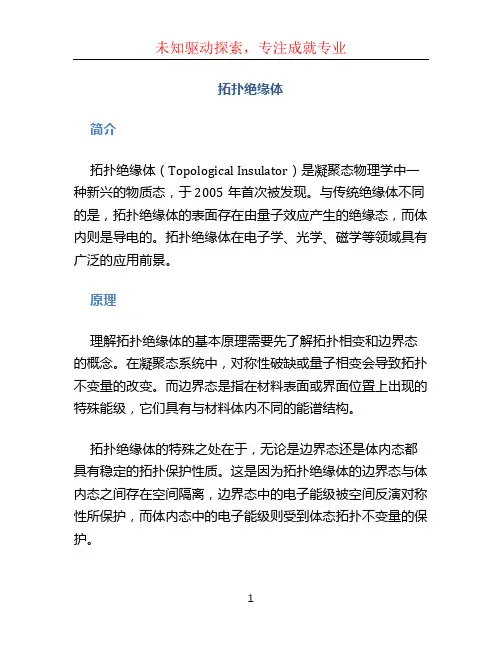
拓扑绝缘体简介拓扑绝缘体(Topological Insulator)是凝聚态物理学中一种新兴的物质态,于2005年首次被发现。
与传统绝缘体不同的是,拓扑绝缘体的表面存在由量子效应产生的绝缘态,而体内则是导电的。
拓扑绝缘体在电子学、光学、磁学等领域具有广泛的应用前景。
原理理解拓扑绝缘体的基本原理需要先了解拓扑相变和边界态的概念。
在凝聚态系统中,对称性破缺或量子相变会导致拓扑不变量的改变。
而边界态是指在材料表面或界面位置上出现的特殊能级,它们具有与材料体内不同的能谱结构。
拓扑绝缘体的特殊之处在于,无论是边界态还是体内态都具有稳定的拓扑保护性质。
这是因为拓扑绝缘体的边界态与体内态之间存在空间隔离,边界态中的电子能级被空间反演对称性所保护,而体内态中的电子能级则受到体态拓扑不变量的保护。
目前,实现拓扑绝缘体的方法主要有两种:材料设计和量子干涉。
通过精心设计晶体结构和选择适当的杂质掺杂,可以实现拓扑绝缘体的制备。
此外,在一些量子系统中,通过调控量子干涉效应,也可以实现拓扑绝缘体的产生。
材料设计材料设计是实现拓扑绝缘体的一种重要方法。
通过选择不同的材料组合和晶体结构,可以实现表面态绝缘体能级与体态能级之间的空间隔离。
一种常见的材料设计方法是利用拓扑绝缘体的重要代表材料——拓扑绝缘体,例如砷化铋(Bi2Se3)和砷化锑(Sb2Te3)。
这些材料的拓扑绝缘体性质主要来自于其特殊的能带结构。
量子干涉量子干涉是另一种实现拓扑绝缘体的方法。
通过在材料体系中引入量子干涉效应,可以调控能带结构,从而实现拓扑绝缘体。
例如,通过使用过渡金属氧化物(Transition Metal Oxide)界面,可以利用量子干涉效应产生拓扑绝缘体。
拓扑绝缘体在电子学、光学和磁学等领域具有广泛的应用前景。
在电子学领域,拓扑绝缘体的边界态具有高度的迁移率和长寿命,对于制备高速、低功耗的电子器件具有重要意义。
例如,利用拓扑绝缘体的边界态可以实现高效的电子输运和信息传输。
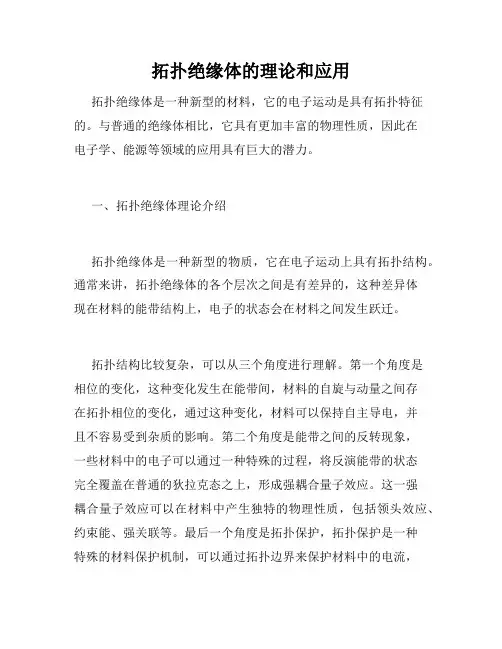
拓扑绝缘体的理论和应用拓扑绝缘体是一种新型的材料,它的电子运动是具有拓扑特征的。
与普通的绝缘体相比,它具有更加丰富的物理性质,因此在电子学、能源等领域的应用具有巨大的潜力。
一、拓扑绝缘体理论介绍拓扑绝缘体是一种新型的物质,它在电子运动上具有拓扑结构。
通常来讲,拓扑绝缘体的各个层次之间是有差异的,这种差异体现在材料的能带结构上,电子的状态会在材料之间发生跃迁。
拓扑结构比较复杂,可以从三个角度进行理解。
第一个角度是相位的变化,这种变化发生在能带间,材料的自旋与动量之间存在拓扑相位的变化,通过这种变化,材料可以保持自主导电,并且不容易受到杂质的影响。
第二个角度是能带之间的反转现象,一些材料中的电子可以通过一种特殊的过程,将反演能带的状态完全覆盖在普通的狄拉克态之上,形成强耦合量子效应。
这一强耦合量子效应可以在材料中产生独特的物理性质,包括领头效应、约束能、强关联等。
最后一个角度是拓扑保护,拓扑保护是一种特殊的材料保护机制,可以通过拓扑边界来保护材料中的电流,即便材料表面上排列着大量的夹杂和杂质分子,电流也可以顺利地穿过这些杂质分子,表现出强大的抵抗干扰的能力。
二、拓扑绝缘体的特性1、拓扑保护及狄拉克锥拓扑保护是拓扑绝缘体的一种核心特性,其通过在材料内部的特殊拓扑结构构建安全的电子运输通道。
对于分数量子霍尔体,边界状态将在外基体地形特征保护下产生,以保留量子霍尔效应下的精细平衡。
在位于电子上方的导带巨大磁场下,编织磁通线的贯穿磁输运使得中间的拓扑绝缘体具有巨大的抗杂质能力。
同样,相对于这个工作流,拓扑绝缘体的区域在通常波长下表现出了极大的反射度和透射度。
与此同时,拓扑绝缘体中的电子还表现出了一个非常特殊的性质,即狄拉克锥。
所谓狄拉克锥,就是说拓扑绝缘体中的电子可以在光带上拥有一定的数量,而且他们为空穴。
这些空穴称之为狄拉克锥。
在介绍数学方法的基础上,锥唯一在光带的带底拥有一定的数量,这允许在其处可以形成大量的配对效应,这通常与光带的内部自旋激发形成很强的耦合。
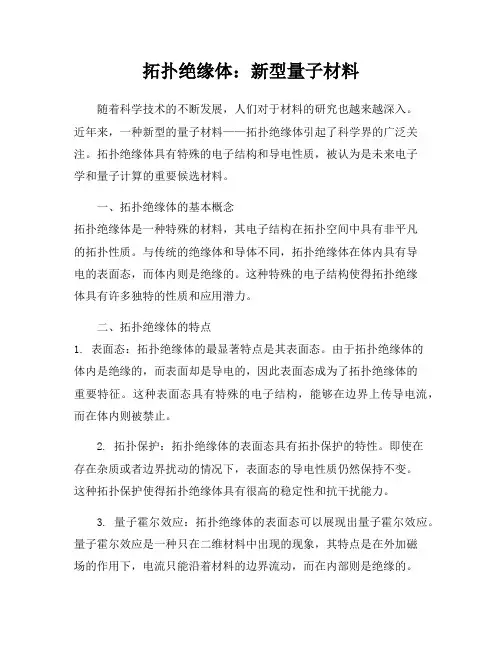
拓扑绝缘体:新型量子材料随着科学技术的不断发展,人们对于材料的研究也越来越深入。
近年来,一种新型的量子材料——拓扑绝缘体引起了科学界的广泛关注。
拓扑绝缘体具有特殊的电子结构和导电性质,被认为是未来电子学和量子计算的重要候选材料。
一、拓扑绝缘体的基本概念拓扑绝缘体是一种特殊的材料,其电子结构在拓扑空间中具有非平凡的拓扑性质。
与传统的绝缘体和导体不同,拓扑绝缘体在体内具有导电的表面态,而体内则是绝缘的。
这种特殊的电子结构使得拓扑绝缘体具有许多独特的性质和应用潜力。
二、拓扑绝缘体的特点1. 表面态:拓扑绝缘体的最显著特点是其表面态。
由于拓扑绝缘体的体内是绝缘的,而表面却是导电的,因此表面态成为了拓扑绝缘体的重要特征。
这种表面态具有特殊的电子结构,能够在边界上传导电流,而在体内则被禁止。
2. 拓扑保护:拓扑绝缘体的表面态具有拓扑保护的特性。
即使在存在杂质或者边界扰动的情况下,表面态的导电性质仍然保持不变。
这种拓扑保护使得拓扑绝缘体具有很高的稳定性和抗干扰能力。
3. 量子霍尔效应:拓扑绝缘体的表面态可以展现出量子霍尔效应。
量子霍尔效应是一种只在二维材料中出现的现象,其特点是在外加磁场的作用下,电流只能沿着材料的边界流动,而在内部则是绝缘的。
拓扑绝缘体的表面态可以模拟二维材料的量子霍尔效应,从而展现出类似的导电性质。
三、拓扑绝缘体的应用前景1. 量子计算:拓扑绝缘体的特殊电子结构使其成为量子计算的理想平台。
拓扑绝缘体的表面态具有拓扑保护的特性,可以有效地抵抗外界的干扰,从而保持量子比特的稳定性。
这为实现高效、稳定的量子计算提供了新的可能性。
2. 电子学器件:拓扑绝缘体的导电性质使其在电子学器件方面具有广阔的应用前景。
拓扑绝缘体的表面态可以用来传导电流,而体内则是绝缘的,这为设计新型的电子器件提供了新的思路和方法。
3. 自旋电子学:拓扑绝缘体的表面态还具有特殊的自旋结构,可以用来实现自旋电子学。
自旋电子学是一种利用电子的自旋来进行信息存储和处理的新兴领域,拓扑绝缘体的出现为自旋电子学的发展提供了新的材料基础。
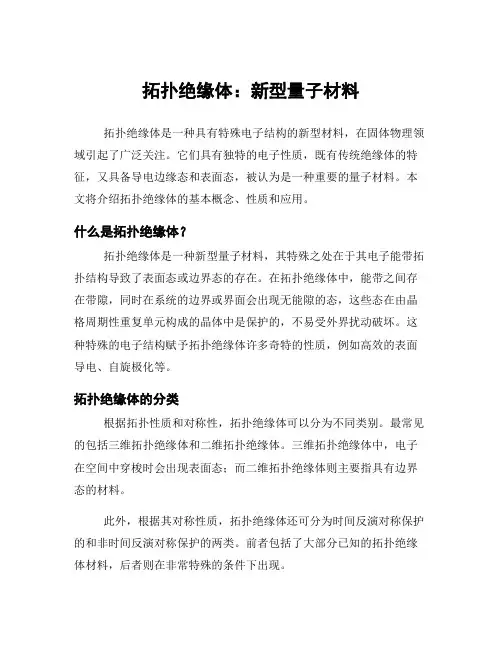
拓扑绝缘体:新型量子材料拓扑绝缘体是一种具有特殊电子结构的新型材料,在固体物理领域引起了广泛关注。
它们具有独特的电子性质,既有传统绝缘体的特征,又具备导电边缘态和表面态,被认为是一种重要的量子材料。
本文将介绍拓扑绝缘体的基本概念、性质和应用。
什么是拓扑绝缘体?拓扑绝缘体是一种新型量子材料,其特殊之处在于其电子能带拓扑结构导致了表面态或边界态的存在。
在拓扑绝缘体中,能带之间存在带隙,同时在系统的边界或界面会出现无能隙的态,这些态在由晶格周期性重复单元构成的晶体中是保护的,不易受外界扰动破坏。
这种特殊的电子结构赋予拓扑绝缘体许多奇特的性质,例如高效的表面导电、自旋极化等。
拓扑绝缘体的分类根据拓扑性质和对称性,拓扑绝缘体可以分为不同类别。
最常见的包括三维拓扑绝缘体和二维拓扑绝缘体。
三维拓扑绝缘体中,电子在空间中穿梭时会出现表面态;而二维拓扑绝缘体则主要指具有边界态的材料。
此外,根据其对称性质,拓扑绝缘体还可分为时间反演对称保护的和非时间反演对称保护的两类。
前者包括了大部分已知的拓扑绝缘体材料,后者则在非常特殊的条件下出现。
拓扑绝缘体的发现与研究历程拓扑绝缘体作为一种新奇的量子材料,在近年来得到了广泛研究。
最早关于拓扑绝缘体的概念可以追溯到20世纪80年代,但直到近年来,随着实验技术和理论方法的进步,科学家们才成功合成并验证了一系列具有拓扑性质的材料。
其中,最著名的是锡-碲(SnTe)这种三维拓扑绝缘体材料。
通过对其晶格结构和电子能带进行精确计算和实验证实,锡-碲是第一个被确认为三维拓扑绝缘体的物质。
这一发现引发了科学界对拓扑物态学领域研究热潮,各种新型拓扑材料被相继发现。
拓扑绝缘体的应用前景由于其独特的电子结构和性质,拓扑绝缘体在量子信息、纳米电子学、量子计算等领域具有广泛应用前景。
例如,利用表面态或边界态可以实现高效自旋输运,在量子计算中可以用于构建拓扑量子比特等。
此外,由于边界态具有高度迷离度,在光伏器件、热电材料等能源转换领域也有潜在应用价值。

拓扑绝缘体与拓扑半金属什么是拓扑绝缘体?拓扑绝缘体是一种物理学中的概念,它指的是具有绝缘体的电子传导性质,但却存在着非平凡拓扑的物理性质。
它的本质在于,电子在固体中的运动不仅取决于晶格结构和化学成分,还与时间反演对称性的破缺有关。
因此,拓扑绝缘体在项目个人、拓扑电子学等领域具有广泛的应用。
拓扑绝缘体与量子霍尔效应在拓扑绝缘体的研究中,量子霍尔效应是最先被发现的拓扑现象之一。
量子霍尔效应指的是,当二维电子系统面对外加磁场时,会产生一种新的电导现象。
在这个过程中,电子会沿着材料表面沿着固定的方向运动,这种电导现象与普通的电导现象不同,因为它是由霍尔效应引起的,并且只有在特定的条件下才会观察到。
拓扑绝缘体与托普分数除了量子霍尔效应以外,拓扑绝缘体还与托普分数密切相关。
托普分数指的是一种将各种物理现象进行分类的方法,它可以区分不同的拓扑相,在物理学中具有很大的作用。
拓扑绝缘体的分类正是依赖于托普分数的。
拓扑半金属及其特性拓扑半金属是与拓扑绝缘体类似的一种物理现象,它介于一般的金属和拓扑绝缘体之间。
拓扑半金属的表面电子在某些方向上有导电性,而在另外一些方向上则是绝缘的。
相比于一般的金属,在拓扑半金属中导电性也有关联。
一般情况下,金属的电导性来源于自由电子。
但在拓扑半金属中,则可能存在非常规的电子能带。
这些非常规能带可以由物理学中的拓扑量子数描述,因此被称为“拓扑能带”。
拓扑绝缘体与拓扑半金属的研究现状目前,拓扑绝缘体与拓扑半金属的研究已经成为了物理学中一个非常重要的领域。
在这个领域中,研究人员使用各种各样的实验手段与理论模型,努力探求物质中的拓扑性质。
这些工作不仅有助于深入理解基本物理学中的概念,也为人们创造出更先进的材料和电子器件打下了基础。
,拓扑绝缘体与拓扑半金属是物理学家们在近几十年中共同努力的结果。
它们的性质和应用非常广泛,已经成为了物理学中非常重要的研究领域之一。
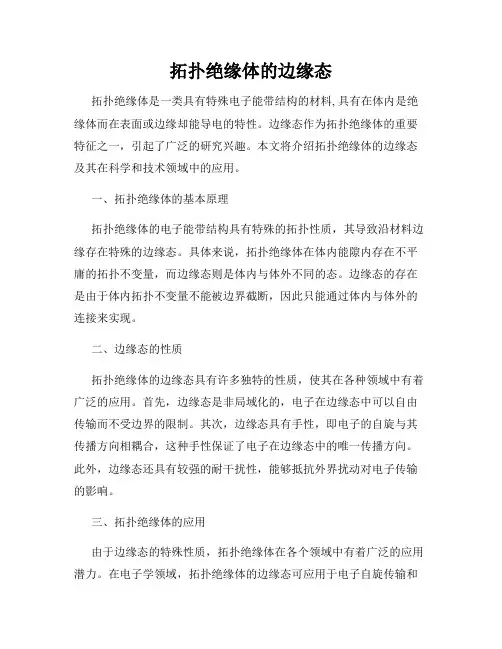
拓扑绝缘体的边缘态拓扑绝缘体是一类具有特殊电子能带结构的材料, 具有在体内是绝缘体而在表面或边缘却能导电的特性。
边缘态作为拓扑绝缘体的重要特征之一,引起了广泛的研究兴趣。
本文将介绍拓扑绝缘体的边缘态及其在科学和技术领域中的应用。
一、拓扑绝缘体的基本原理拓扑绝缘体的电子能带结构具有特殊的拓扑性质,其导致沿材料边缘存在特殊的边缘态。
具体来说,拓扑绝缘体在体内能隙内存在不平庸的拓扑不变量,而边缘态则是体内与体外不同的态。
边缘态的存在是由于体内拓扑不变量不能被边界截断,因此只能通过体内与体外的连接来实现。
二、边缘态的性质拓扑绝缘体的边缘态具有许多独特的性质,使其在各种领域中有着广泛的应用。
首先,边缘态是非局域化的,电子在边缘态中可以自由传输而不受边界的限制。
其次,边缘态具有手性,即电子的自旋与其传播方向相耦合,这种手性保证了电子在边缘态中的唯一传播方向。
此外,边缘态还具有较强的耐干扰性,能够抵抗外界扰动对电子传输的影响。
三、拓扑绝缘体的应用由于边缘态的特殊性质,拓扑绝缘体在各个领域中有着广泛的应用潜力。
在电子学领域,拓扑绝缘体的边缘态可应用于电子自旋传输和量子计算等方面。
利用边缘态的非局域性和手性,可以实现高效的信息传输和存储。
在光学领域,边缘态的光学特性使其成为新型光学器件的重要组成部分。
例如,拓扑绝缘体的边缘态可以用来实现高效的光子传输和耐干扰的光学器件。
此外,拓扑绝缘体的边缘态还在拓扑量子计算和拓扑量子纠错等方面有着广泛的应用前景。
四、拓扑绝缘体的研究进展近年来,拓扑绝缘体的研究取得了许多重要进展。
通过材料工程和器件设计,已经实现了多种拓扑绝缘体材料的合成和调控。
同时,实验观测到了多种拓扑绝缘体的边缘态。
通过精确的实验测量和理论建模,揭示了拓扑绝缘体的各种特性和行为。
这些研究进展为拓扑绝缘体的应用提供了有力的支持和指导。
总结:拓扑绝缘体的边缘态作为其重要特征之一,在科学和技术领域中具有重要的应用潜力。
拓扑绝缘体简介一、本文概述拓扑绝缘体是一种特殊的物质状态,其独特的电子结构和性质在凝聚态物理领域引起了广泛的关注。
本文将简要介绍拓扑绝缘体的基本概念、发展历程、主要特性以及潜在的应用前景。
我们将从拓扑绝缘体的定义出发,阐述其与传统绝缘体和金属的区别,并探讨其独特的边缘态和电子自旋特性。
我们还将概述拓扑绝缘体在量子计算、自旋电子学以及新能源技术等领域的应用潜力,以期为读者提供一个全面而深入的拓扑绝缘体知识框架。
二、拓扑绝缘体的基本性质拓扑绝缘体是一种特殊的物态,其独特性质源自其能带结构中的拓扑非平庸性质。
这些性质使得拓扑绝缘体在基础物理学研究和应用科学技术领域都具有重要的价值。
拓扑绝缘体的体态具有绝缘性,即在其内部不存在可供电流通过的通道。
然而,其表面或边界却具有导电性,这是由于拓扑绝缘体的能带结构中存在特殊的边缘态或表面态。
这些边缘态或表面态的电子在材料内部受到拓扑保护,无法被散射到体态中,因此可以在材料表面或边界上自由移动,形成导电通道。
拓扑绝缘体的导电性质具有独特的自旋依赖性。
在拓扑绝缘体的表面态中,电子的自旋方向与运动方向紧密相关,形成了一种称为自旋-动量锁定的现象。
这种现象使得拓扑绝缘体在自旋电子学和量子计算等领域具有潜在的应用价值。
拓扑绝缘体还具有一些其他独特的性质,如量子霍尔效应、量子自旋霍尔效应等。
这些效应都是拓扑绝缘体能带结构中的拓扑非平庸性质所导致的。
它们不仅为物理学家提供了研究新型量子物态的机会,也为电子学和信息技术领域的发展提供了新的可能。
拓扑绝缘体的基本性质包括体态绝缘性、表面或边界导电性、自旋依赖的导电性质以及量子霍尔效应等。
这些性质使得拓扑绝缘体在基础物理学研究和应用科学技术领域都具有广阔的前景和潜力。
三、拓扑绝缘体的分类与实例拓扑绝缘体,作为一类特殊的物质状态,可以根据其能带结构和表面态性质进行分类。
最常见的分类方式是根据其能带结构的特性,分为时间反演不变拓扑绝缘体和晶体对称性保护拓扑绝缘体。
拓扑绝缘体的能带结构拓扑绝缘体,听起来是不是有点神秘?别担心,今天咱们就来聊聊它的能带结构,别看它名字高大上,实际上它的原理就像是一个复杂的魔法,你一不小心就可能发现自己进入了一个不一样的世界。
简单点说,拓扑绝缘体是一种特殊的材料,它的内部像是绝缘体一样,电流走不进去,但表面却能导电。
就像是你拿着一块看起来完全不可能通电的石头,结果它的表面却意外地给你通上了电,牛不牛?首先咱们得了解一下它的能带结构,咱们都知道,材料的电子行为跟它的能带结构关系密切。
比如,常见的导体、绝缘体、半导体啥的,都是根据能带来区分的。
能带,简单理解就是电子在材料中能够存在的能量范围。
导体的能带里,电子是“满载”的,能够自由流动;绝缘体的能带里,电子基本都被“关”在低能区,根本不动;半导体的情况就像是一个“有点放不开”的孩子,能动,但是需要一点外力才能激发。
但是拓扑绝缘体有点儿不一样。
它的内部看似像一个普通的绝缘体,可是一旦到了表面,嘿,这就像魔术一样,表面突然变成了导电的状态。
这是因为它的能带结构有一些非常奇特的“顶层”设计,让它的表面状态发生了质的变化。
具体来说,拓扑绝缘体的能带结构具有某种“拓扑保护”,这就像是一个超级强的保护罩,把电子束缚在表面,让它们不受外界的干扰。
换句话说,外部的杂质、缺陷这些在表面上几乎没办法影响电子的流动,电子可以“安安稳稳地”在表面上跑来跑去。
你想啊,平时我们说到导电材料,都是看它的内部能不能让电子自由流动。
拓扑绝缘体的奇特之处就在于,它并不依赖于内部的电导,而是通过一种特殊的表面状态来实现导电。
这种现象其实是由它的量子力学特性决定的,它的能带结构和普通材料完全不一样,表面上会有一些“特殊的轨道”让电子能够通过。
就像是给它的表面“开了一扇窗”,电子就能够从这个窗户溜出来,跑到表面上去“溜达”了。
咱们回过头来看,这种能带结构的“保护机制”其实并不简单,它背后有个非常酷的概念,叫做“自旋”。
自旋是电子的一种量子属性,可以简单理解为电子好像有一个小小的磁场一样,指向某个方向。
拓扑绝缘体的理论与实验研究拓扑绝缘体(Topological insulator)是一种新型的材料,它在内部是绝缘体,但在表面却是导体。
这种特殊的性质使得拓扑绝缘体在电子学和量子计算领域具有巨大的应用潜力。
本文将着重介绍拓扑绝缘体的理论基础和实验研究进展。
一、理论基础1. 历史回顾拓扑绝缘体的研究起源于对量子霍尔效应的深入研究。
在1980年代,科学家发现在二维电子系统中,在一定的外加磁场下,电子会出现沿着边界循环运动的现象,这便是量子霍尔效应。
进一步的研究揭示了量子霍尔效应的拓扑性质,为拓扑绝缘体的产生奠定了基础。
2. 拓扑绝缘体的理论模型拓扑绝缘体的理论基础可以用量子力学中的哈密顿量来描述。
研究人员发现,拓扑绝缘体的表面态与体态之间存在着显著的拓扑差异,而这种差异正是导致表面导电的关键。
拓扑绝缘体的理论模型主要包括具有平带结构的模型和强相互作用效应下的模型,通过这些模型,可以更好地理解拓扑绝缘体的性质与行为。
二、实验研究进展1. 材料设计与合成拓扑绝缘体的实验研究首先需要设计和合成具有特殊结构和性质的材料。
研究人员通过充分了解拓扑绝缘体的理论基础,可以有针对性地设计材料的结构和化学组成,以实现拓扑绝缘体的产生。
例如,利用外加的适当的电场或磁场,可以在某些材料上诱导出拓扑绝缘体相。
2. 表面态的探测与分析拓扑绝缘体的独特之处在于其内部是绝缘体,而表面却是导体。
因此,研究人员需要开发出有效的实验手段来观测和分析拓扑绝缘体的表面态。
目前常用的技术包括扫描隧道显微镜(STM)和角分辨光电子能谱仪(ARPES),这些技术可以提供高分辨率的表面态图像和能带结构信息。
3. 电输运性质的研究除了表面态的研究,研究人员还关注拓扑绝缘体的电输运性质。
通过测量拓扑绝缘体的电阻、霍尔效应等物理量,可以研究其电子输运行为以及拓扑保护特性。
实验研究发现,在拓扑绝缘体中,电子有着不同寻常的输运行为,比如平整的霍尔电导曲线和零磁场下的电流反常等现象。
分析拓扑绝缘体的物理性质拓扑绝缘体是一种新型的材料,它具有与传统绝缘体不同的物理性质。
本文将分析拓扑绝缘体的几个重要物理性质,包括边界态、色散关系和拓扑不变量。
拓扑绝缘体的一个重要特征是其边界态。
在拓扑绝缘体中,当能带之间存在带隙时,能量位于带隙中的态会出现在材料的边界上。
这些边界态具有特殊的性质,比如在能谱上分布连续,与体态之间没有能隙等。
这使得拓扑绝缘体在器件应用中具有潜力,比如用于量子计算或信息传输。
拓扑绝缘体的带隙中还存在一种特殊的能带交叉点,称为Dirac点。
Dirac点是一种具有线性色散关系的能带交叉点,其能谱呈现出V字型的形状。
这种色散关系与传统绝缘体或金属中的抛物线形色散关系有所不同。
Dirac点的存在使得拓扑绝缘体在输运性质上具有一些特殊的性质,比如它们的电导率在低能态下与温度无关,即呈现出相对稳定的输运行为。
拓扑绝缘体的另一个重要物理性质是其拓扑不变量。
拓扑不变量可以看作是描述拓扑物态的一种量子数,它们在拓扑绝缘体的带隙关闭时不会改变。
更具体地说,它们与能带拓扑结构之间的关系有关。
这些拓扑不变量可以通过拓扑绝缘体的能带结构来计算,例如沃尔德费尔德不变量、楞次数等。
拓扑不变量的存在使得拓扑绝缘体在多尺度物性和边界态的稳定性方面具有独特的性质。
除了上述物理性质,拓扑绝缘体还具有一些其他特殊的性质。
比如,它们在外部干扰下表现出的抗循环行为。
这种行为与传统绝缘体或金属中的电流输运行为有所不同。
此外,拓扑绝缘体还具有非局域性,即边界上的态可以在整个系统中传播,而不仅仅局限在边界附近。
总之,拓扑绝缘体是一类具有特殊物理性质的材料。
它们的边界态、色散关系和拓扑不变量使得它们在量子计算、信息传输等领域具有潜在的应用价值。
同时,拓扑绝缘体还具有一些其他特殊性质,如抗循环行为和非局域性。
这些物理性质的理解和研究将为材料科学和凝聚态物理学的发展带来新的机遇。
拓扑绝缘体材料的制备与性质研究拓扑绝缘体(Topological Insulator)作为一种新兴的材料,具有特殊的电子结构和丰富的物理性质,引起了广泛的研究兴趣。
本文将介绍拓扑绝缘体材料的制备方法以及其独特的性质。
一、拓扑绝缘体的制备方法1.外延生长法外延生长法是制备拓扑绝缘体的一种常用方法。
一般采用分子束外延(MBE)或金属有机化学气相沉积(MOCVD)等技术,通过在晶体衬底上沉积原子层薄膜,使得晶体结构具有特殊的拓扑性质。
2.化学合成法化学合成法是另一种常见的拓扑绝缘体制备方法。
通过合成特定化学组成和结构的化合物,如硒化铋(Bi2Se3)、硒化锡(SnSe2)等,可以得到拓扑绝缘体材料。
3.离子液体法离子液体法是一种新兴的制备拓扑绝缘体的方法。
通过在离子液体中溶解特定的化合物或金属离子,并通过电化学反应或热解反应,可以制备出具有拓扑绝缘体性质的材料。
二、拓扑绝缘体的性质研究1.拓扑保护的表面态拓扑绝缘体具有在体态能带中存在的拓扑保护的表面态。
这些表面态能够在晶体中存在杂质或缺陷的情况下保持不变,具有非常高的稳定性。
2.强狄拉克费米子拓扑绝缘体表面的电子结构呈现狄拉克锥状能带,其中的狄拉克费米子质量接近零,速度非常高。
这种特殊的电子结构使得拓扑绝缘体具有优异的电子传输性质。
3.自旋-轨道耦合效应拓扑绝缘体中的自旋-轨道耦合效应是其特殊性质之一。
自旋-轨道耦合可以在表面态和体态之间实现耦合,使得拓扑绝缘体具有自旋流输送的特性。
4.量子霍尔效应由于其特殊的电子结构,拓扑绝缘体表面的载流子在外加磁场作用下可以呈现量子霍尔效应,即洛伦兹力将电流限制在材料的边界上,形成电流的分立通道。
三、应用前景与展望拓扑绝缘体材料的研究与应用具有广泛的前景。
其在信息存储、量子计算和低功耗电子器件等领域具有重要的应用潜力。
例如,拓扑绝缘体的表面态可以用于实现更稳定的量子比特,从而提高量子计算的可靠性和稳定性。
此外,还可以利用拓扑绝缘体中特殊的自旋-轨道耦合效应,实现自旋操控和自旋电子学器件的制备。
Quantum anomalous Hall effect in stable 1T-YN 2monolayer witha large nontrivial band gap and high Chern numberXiangru Kong,1Linyang Li,2,∗Ortwin Leenaerts,2WeiyangWang,2,3Xiong-Jun Liu,1and Fran¸c ois M.Peeters 21International Center for Quantum Materials,Peking University,and Collaborative Innovation Center of Quantum Matter,100871Beijing,China 2Department of Physics,University of Antwerp,Groenenborgerlaan 171,B-2020Antwerp,Belgium 3School of Physics and Electronics Information,Shangrao Normal University,334001Shangrao,Jiangxi,China (Dated:July 7,2017)Abstract The quantum anomalous Hall (QAH)effect is a topologically nontrivial phase,characterized by a non-zero Chern number and chiral edge states,which recently has been realized in ing first-principles calculations,we demonstrate the presence of the QAH effect in 1T-YN 2monolayers,which was recently predicted to be a Dirac half metal without spin-orbit coupling (SOC).We show that the inclusion of SOC opens up a large nontrivial band gap of nearly 0.1eV in its electronic band structure.This results in the nontrivial topological properties confirmed by the Berry curvature,anomalous Hall conductance and the presence of chiral edge states.Remarkably,a high Chern number C =3is found,and there are three corresponding gapless chiral edge states emerging inside the bulk gap.Our study will enrich the family of QAH insulators.∗linyang.li@uantwerpen.bea r X i v :1707.01841v 1 [c o n d -m a t .m t r l -s c i ] 6 J u l 2017I.INTRODUCTIONThe quantum Hall effect was thefirst discovered topological phase in condensed matter physics.It was realized in two-dimensional(2D)electronic systems in the presence of a strong perpendicular external magneticfield[1].The quantization of Landau levels in the 2D limit is the key to the quantum Hall effect[2],but it needs a strong external magnetic field.The anomalous Hall effect was detected in ferromagnetic(FM)metals without an external magneticfield[3]and thefirst theoretical proposal for the quantum anomalous Hall(QAH)effect was made by Haldane in1988for a2D honeycomb lattice toy model[4]. Before the discovery of the quantum spin Hall(QSH)effect[5,6],there was little progress in thisfield besides the localization of band electrons for the realization of the QAH effect[7]. The QSH effect can be considered as two copies of the QAH effect for the opposite spins, i.e.the spin-helical gapless edge states in the QSH effect consist of two counter-propagating chiral edge states with opposite Chern numbers[8].Recent developments in2D materials [9]and QSH studies have broadened the view for realizing the QAH effect[10].However, proposals for realistic materials have resulted in little progress untilfirst-principles studies were made on magnetic2D topologically insulating(TI)thinfilms[11]and graphene with Fe adatoms[12].Since then,four conditions that must be satisfied simultaneously to realize the QAH effect in realistic materials have been identified.The system should be2D,insulating, time-reversal symmetry(TRS)broken with a certain magnetic ordering,and have a non-zero Chern number in the valence bands[13,14].Based on the above conditions,many kinds of QAH insulators have been proposed,including the magnetically doped quantum well-based2D-TIs[15],graphene with transition metal(TM)adatoms(3d,4d and5d)[16–18], buckled honeycomb-lattice systems of group IV or V elements with TM adatoms[19–21], half-functionalized honeycomb-lattice systems[22,23],heterostructure quantum wells[24], and organic metal frameworks[25].Experimentlly,some progress was made to realize the QAH effect in the Cr-doped magnetic topological insulator but,due to the small band gap, this could only be observed at extreme low temperature(30mK)[10].Therefore,searching for other QAH insulators with a larger band gap is urgently needed for experiments and practical applications.Transition metal is defined as an element whose atom has a partiallyfilled d sub-shell or which can give rise to cations with an incomplete d sub-shell[26].Due to the partiallyfilled d shell,TMs can have many different oxidation states when forming compounds and show many appealing electronic,magnetic,and catalytic properties.Strong electronegative elements(groups V,VI,and VII)are easily combined with TMs to form stable compounds. One of the most attracting compounds are the transition metal dichalcogenides(TMDs)with chemical composition TMX2,where TM stands for the TM and X is a chalcogen element such as S,Se,or Te[27,28].TMD monolayers have many new physical properties as compared to their bulk counterparts due to their reduced dimensions.As confirmed by experiment, TMDs can exhibit three different structures,called1H,1T,and1T'[29].Usingfirst-principles calculations,TMD monolayers have been predicted to show both semiconducting (1H-MoS2)[30]and conducting(1T-PtSe2)[31]properties,spin polarization effect(1H-VS2) [32]and QSH effect(1T'-WTe2)[29],where some of them have been realized experimentally [27,28].However,the QAH effect has not yet been predicted in TMD structures.A recent expansion of the TMD-like compounds has been realized through MoN2,a nitrogen-rich TM nitrides(TMN)that has been synthesized through a solid-state ion-exchange reaction under high pressure[33].First-principles calculations predict that1H-MoN2monolayer is a high temperature2D FM material with Curie temperature of nearly420K[34].This suggests that combining TM and N atoms can lead to stable2D monolayers exhibiting novel band structures.A natural question arises:can wefind the QAH effect in the TMNs?Previous calculations focused on TMN monolayers with the chemical composition TMN2 (TM=Y,Zr,Nb and Tc)which demonstrated that the most energetically and dynamically stable phase is1T[35–37].Interestingly,the strong nonlocal p orbitals of the N atoms in 1T-YN2result in a Curie temperature of332K.The three unpaired electrons in the two N atoms give1T-YN2a FM ground state with a total magnetic moment of3µB per unit cell. Remarkably,the electronic band structures as obtained from DFT calculations show that 1T-YN2is a p-state Dirac half metal(DHM)in the absence of spin-orbit coupling(SOC).A DHM is defined as a metal in which a Dirac cone exists at the Fermi level in one spin channel and a band gap opens in the other channel[38,39].The100%spin-polarization and massless Dirac fermions in DHMs attracteda lot of attention due to potential applications in high-speed spintronic devices[37].In this paper,we investigate the stable1T-YN2monolayer usingfirst-principles calculations with the inclusion of SOC.We obtain a relatively large nontrivial band gap(≈0.1eV)in the Dirac cone.The nontrivial properties of the1T-YN2 monolayers are further confirmed by the calculation of the Berry curvature,the anomalousHall conductance(AHC),the Chern number,and the corresponding edge states.The large nontrivial band gap and high Chern number are very interesting for practical applications in future nanodevices.PUTATIONAL METHODSThefirst-principles calculations were done with the Vienna ab initio simulation package (VASP)using the projector augmented wave(PAW)method in the framework of Density Functional Theory(DFT)[40–42].The electron exchange-correlation functional was de-scribed by the generalized gradient approximation(GGA)in the form proposed by Perdew, Burke,and Ernzerhof(PBE)[43].The structure relaxation considering both the atomic positions and lattice vectors was performed by the conjugate gradient(CG)scheme until the maximum force on each atom was less than0.01eV/˚A,and the total energy was con-verged to10−5eV.To avoid unnecessary interactions between the YN2monolayer and its periodic images,the vacuum layer is set to at least17˚A.The energy cutoffof the plane waves was chosen as500eV.The Brillouin zone(BZ)integration was sampled by using a 31×31×1Γ-centered Monkhorst-Pack grid.To obtain a more reliable calculation for the electronic band structure,especially the band gap,the screened Heyd-Scuseria-Ernzerhof Hybrid functional method(HSE06)[44,45]was also used with a15×15×1Γ-centered Monkhorst-Pack grid for BZ integration.SOC is included by a second variational procedure on a fully self-consistent basis.An effective tight-binding Hamiltonian constructed from the maximally localized Wannier functions(MLWF)was used to investigate the surface states [46].The iterative Greens function method[47]was used with the package Wannier tools [48].III.RESULTSSOC is a relativistic effect which describes the interaction of the spin of an electron with its motion[49,50].Though SOC is a small perturbation in a crystalline solid and has little effect on structure and energy,it plays a more important role in the band structure near the Fermi level in the case of the heavy elements.SOC will cause a spin splitting of the energy bands in inversion-asymmetric systems,and more importantly,it can result in a band0.3(a)(b)(c)FIG.1.(a)The octahedral structure unit of 1T-YN 2monolayer and the corresponding 2D Brillouin zone with its high symmetry points (Γ,M and K).b 1and b 2are the reciprocal lattice vectors.The band structure is calculated along the green path (Γ-M-K-Γ).(b)Band structures of 1T-YN 2monolayer with SOC calculated at the PBE and HSE06levels.The blue lines indicate the PBE calculations,and the red lines indicate the HSE06calcaulations.(c)The enlarged band structures shown in the green rectangle in (b).The band gaps are indicated below the figure:∆E P BE =29.7meV ,∆E HSE 06=97.5meV.opening and a band inversion that gives rise to fascinating phenomena.Previous studies did not consider SOC in 1T-YN 2,although the SOC effect of the Y and N atoms are not negligible.In the following,we will take SOC into account and study the electronic band structure of stable 1T-YN 2monolayer by first-principles calculations.The space group of YN 2is P 3m 1(No.164,D 33d ),and its WyckoffPositions are Y (0,0,0)and N (1/3,2/3,z )with z =0.04489.As shown in Fig.1(a),the Y atom is the inversion center in the octahedral structure unit and the three N atoms in the upper layer will turn into the three N atoms in the lower layer under inversion.The optimised lattice parameter and Y-N bond distance are 3.776and 2.350˚A ,respectively,which is in good agreement with previous calculations [37].Without SOC,we observe a distorted Dirac cone along the M-Khigh-symmetry line both at the PBE and HSE06level.Similar band structures can also be observed in other2D non-magnetic systems,such as the TaCX[51]and the distorted hexagonal frameworks GaBi-X2(X=I,Br,Cl)[52].However,distorted Dirac cones in 2D magnetic systems are rare.The calculated band structures with SOC are shown in Fig.1(b).The blue lines indicate the band structure at the PBE level and a band gap(29.7 meV)can be observed at the Fermi level along the M-K high-symmetry line.The semilocal approximations to the exchange-correlation energy at the PBE level underestimate the band gap with respect to experiment and overestimate electron delocalization effects for many d-element compounds.Therefore,calculations at the HSE06level are necessary to give more reliable band gaps and band structures.We found that the band gap at the HSE06level is larger than that at the PBE level.To see the difference more clearly,the enlarged band structure are shown in Fig.1(c).The calculated band gap at the PBE level is∆E P BE= 29.7meV,while that at the HSE06level∆E HSE06increases to97.5meV.By projecting the wavefunctions onto the spherical harmonics,we analysed the occupation of the different atomic orbitals both with and without SOC near the Fermi level.Though there are minor contributions of d orbitals from the Y atom near the Fermi level,the major contribution of the atomic orbitals comes from the p orbitals of the N atoms.This is consistent with previous study[37].Next,we constructed a tight-binding Halmitonian with12Wannier functions by projecting the p x,p y,and p z orbitals of the two N atoms in the unit cell of 1T-YN2to further examine the electronic band structure.Despite the difference in the band gap,the main character close to the Fermi level at the PBE and HSE06level with SOC are qualitatively the same.In the following analysis,we will consider the results at the PBE level with SOC.To investigate the topological properties of1T-YN2,wefirst calculated the gauge-invariant Berry curvature in momentum space.The Berry curvatureΩz(k)in2D can be obtained by analyzing the Bloch wave functions from the self-consistent potentials:Ωz(k)=n f nΩzn(k),(1)Ωzn (k)=−2m=nImψn(k)|υx|ψm(k) ψm(k)|υy|ψn(k)( m(k)− n(k))2,(2)where,f n is the Fermi-Dirac distribution function,υx(y)is the velocity operator,ψn(k)is the Bloch wave function, n is the eigenvalue and the summation is over all n occupied bandsKKMFIG.2.The reproduced band structures along the path K-M-K'(blue curves)with MLWF basises and the distribution of the corresponding Berry curvature in momentum space(red curves).The inset indicates the position of the peaks of the Berry curvature in the2D Brillouin zone.below the Fermi level(m indicates the unoccupied bands above the Fermi level).In Fig.2 the reproduced band structure(blue curves)and Berry curvature(red curves)along the high symmetry direction K-M-K',calculated by Wannier interpolation[46],are shown.As can be observed,the nonzero Berry curvature is mainly distributed around the avoided band crossings at the Fermi level.The peaks in the Berry curvature at the two sides of the M point have the same sign.Furthermore,a plot of the Berry curvature peaks over the whole Brillioun zone(see inset of Fig.2)indicates that all6peaks have the same sign because of inversion symmetry.The Chern number is obtained by integrating the Berry curvatureΩz(k)over the BZ,C=12πBZd2kΩz(k).(3)The Chern number C is an integer and gives rise to the quantized charge Hall conductance:σxy=Ce2/h.σxy is also known as the AHC,and the calculated chemical-potential-resolved AHC is shown in Fig.3(a).A nontrivial gap of about30meV and a Chern number C=3 can be deduced from the plateau near the Fermi level.The non-zero Chern number can also be confirmed by evaluating the electronic polarization P e at discrete points in one primitive reciprocal lattice vector k y=k i[53–55].In another primitive reciprocal lattice vector k x,��������������������������������������������������������������������������FIG.3.(a)The chemical-potential-resolved AHC when the Fermi level is shifted to zero.(b)The change in the electronic polarization P e .the hybrid Wannier charge centers (WCCs)can be defined asx n (k y )=i 2π π−πdk x u n (k x ,k y )|∂k x |u n (k x ,k y ) ,(4)where u n (k x ,k y )is the periodic part of the Bloch function ψn (k ).The sum of the hybrid WCCs x n will give the electronic polarization P e =e n x n (k i )(e stands for the electronic charge)which is gauge invariant modulo a lattice vector.This brings about a well-defined physical observable ∆P e under a continuous deformation of the system.Thus the Chern number is given byC =1e ∆P e =1e (P e (2π)−P e (0)).(5)As can be seen from Fig.3(b),the electronic polarization P e shifts upwards with the winding number 3,so the Chern number C =3.According to the bulk-edge correspondence [56],the non-zero Chern number is closely related to the number of nontrivial chiral edge states that emerge inside the bulk gap of a semi-infinite system.With an effective concept of principle layers,an iterative procedure to calculate the Green’s function for a semi-infinite system is employed.The momentum and energy dependence of the local density of states at the edge can be obtained from the imaginary part of the surface Green’s function:A (k,ω)=−1πlim η→0+ImTr G s (k,ω+iη),(6)FIG.4.Momentum and energy dependence of local density of states for the states at the edge of a semi-infinite plane(110).and the results are shown in Fig.4.It is clear that there are three gapless chiral edge states that emerge inside the bulk gap connecting the valance and conductance bands and corresponding to a Chern number C=3.IV.DISCUSSIONS AND CONCLUSIONSBy the calculations of Berry Curvature,the AHC,the Chern number,and the correspond-ing edge states,we confirm the topological nontrivial properties of the1T-YN2monolayer. The most significant points of our research can be summarized as follows:(i)The1T-YN2monolayer has a nontrivial band gap of nearly0.1eV which is sufficientto the realization of QAH effect at room temperature in experiment.The found mag-nitude of the nontrivial band gap compares favorably to previous proposals[14,57].The largest band gap among the large number of QSH insulators is1.08eV[58,59], but a band gap in QAH insulators of this order of magnitude has not been discovered.In recent reviews[14,57],some systems have been proposed exhibiting large nontriv-ial band gaps(>0.1eV),but most of them are realized by functionalization methods, such as half functionalization of stanene with I atoms(≈340meV)[23]and half func-tionalization of Bi(111)bilayer with H atoms(≈200meV)[60,61].However,their stability still needs to be confirmed,and realizing such functionalization seems to be difficult to control experimentally.In contrast,note that the stability of1T-YN2has been demonstrated by energetic and dynamical analysis[37].Since MoN2has been realized in experiment[33]and its monolayer stability has been predicted[34], it seems likely that the realization of1T-YN2monolayers is also possible.(ii)Unlike the quantum Hall effect in which the Chern number can be tuned by changing the magneticfield or varying the Fermi level,the Chern number for intrinsic QAH effects in realistic materials are mostly limited to±1and±2[14,57].QAH insulators with high Chern number and corresponding nontrivial chiral edge states are rarely reported.These nontrivial edge states will provide strong currents and signals which are significant in experiments.Thus,the stable1T-YN2monolayer with a high Chern number is expected to lead to important applications in experiments.(iii)To our knowledge,this is thefirst time that the QAH effect is predicted in a2D TMN material.At present,the topological QSH effect was predicted in1T'TMDs[29].On the other hand,some TMD monolayers with square lattice[62]and hexagonal lattice[63]have also been predicted to be2D topological insulators,but such structureshave yet not been observed experimentally.Here,we report that the QAH effect can be realized in the1T structure of TMN,which is a common structure for TMDs in exeperiment.In conclusion,we investigated the electronic band structure of1T-YN2monolayer byfirst-principles calculations in the case of SOC and observed an intrinsic QAH effect.A large nontrivial band gap(≈0.1eV)and high Chern number(C=3)were found.We calculated the Berry curvatureΩz(k)and AHCσxy to demonstrate the nontrivial topological properties. Three nontrivial gapless chiral edge states were found which provide strong evidence for the realization of the QAH effect in experiments.The prediction of the QAH effect in the1T-YN2monolayer provides a different type of structure and material for the investigation of QAH insulators in the TM compounds.ACKNOWLEDGMENTSThis work is supported by Ministry of Science and Technology of China(MOST) (Grant No.2016YFA0301604),National Natural Science Foundation of China(NSFC)(No.11574008),the Thousand-Young-Talent Program of China,and Fonds Wetenschap-pelijk Onderzoek(FWO-Vl).The computational resources and services used in this work were provided by the VSC(Flemish Supercomputer Center),funded by the Research Foun-dation-Flanders(FWO)and the Flemish Government-department EWI,and the National Supercomputing Center in Tianjin,funded by the Collaborative Innovation Center of Quan-tum Matter.W.Wang acknowledgefinancial support from the National Natural Science Foundation of China(Grant No.11404214)and the China Scholarship Council(CSC).[1]K.v.Klitzing,G.Dorda,and M.Pepper,Phys.Rev.Lett.45,494(1980).[2] D.J.Thouless,M.Kohmoto,M.P.Nightingale,and M.den Nijs,Phys.Rev.Lett.49,405(1982).[3]N.Nagaosa,J.Sinova,S.Onoda,A.H.MacDonald,and N.P.Ong,Rev.Mod.Phys.82,1539(2010).[4] F.D.M.Haldane,Phys.Rev.Lett.61,2015(1988).[5]M.Z.Hasan and C.L.Kane,Rev.Mod.Phys.82,3045(2010).[6]X.-L.Qi and S.-C.Zhang,Rev.Mod.Phys.83,1057(2011).[7]M.Onoda and N.Nagaosa,Phys.Rev.Lett.90,206601(2003).[8]X.-L.Qi,Y.-S.Wu,and S.-C.Zhang,Phys.Rev.B74,085308(2006).[9] A.H.Castro Neto,F.Guinea,N.M.R.Peres,K.S.Novoselov,and A.K.Geim,Rev.Mod.Phys.81,109(2009).[10] C.-Z.Chang,J.Zhang,X.Feng,J.Shen,Z.Zhang,M.Guo,K.Li,Y.Ou,P.Wei,L.-L.Wang,Z.-Q.Ji,Y.Feng,S.Ji,X.Chen,J.Jia,X.Dai,Z.Fang,S.-C.Zhang,K.He,Y.Wang,L.Lu, X.-C.Ma,and Q.-K.Xue,Science340,167(2013).[11]R.Yu,W.Zhang,H.-J.Zhang,S.-C.Zhang,X.Dai,and Z.Fang,Science329,61(2010).[12]Z.Qiao,S.A.Yang,W.Feng,W.-K.Tse,J.Ding,Y.Yao,J.Wang,and Q.Niu,Phys.Rev.B82,161414(2010).[13]H.Weng,R.Yu,X.Hu,X.Dai,and Z.Fang,Adv.Phys.64,227(2015).[14]J.Zhang,B.Zhao,T.Zhou,and Z.Yang,Chinese Phys.B25,117308(2016).[15] C.-X.Liu,X.-L.Qi,X.Dai,Z.Fang,and S.-C.Zhang,Phys.Rev.Lett.101,146802(2008).[16]H.Zhang,zo,S.Bl¨u gel,S.Heinze,and Y.Mokrousov,Phys.Rev.Lett.108,056802(2012).[17] C.M.Acosta,M.P.Lima,R.H.Miwa,A.J.R.da Silva,and A.Fazzio,Phys.Rev.B89,155438(2014).[18]J.Hu,Z.Zhu,and R.Wu,Nano Lett.15,2074(2015),pMID:25689149.[19]M.Ezawa,Phys.Rev.Lett.109,055502(2012).[20]H.Zhang,F.Freimuth,G.Bihlmayer,S.Bl¨u gel,and Y.Mokrousov,Phys.Rev.B86,035104(2012).[21]H.Zhang,F.Freimuth,G.Bihlmayer,M.Leˇz ai´c,S.Bl¨u gel,and Y.Mokrousov,Phys.Rev.B87,205132(2013).[22]S.-M.Huang,S.-T.Lee,and C.-Y.Mou,Phys.Rev.B89,195444(2014).[23]S.-C.Wu,G.Shan,and B.Yan,Phys.Rev.Lett.113,256401(2014).[24]K.F.Garrity and D.Vanderbilt,Phys.Rev.Lett.110,116802(2013).[25]Z.F.Wang,Z.Liu,and F.Liu,Phys.Rev.Lett.110,196801(2013).[26] A.D.McNaught and A.D.McNaught,Compendium of chemical terminology,Vol.1669(Blackwell Science Oxford,1997).[27]M.Chhowalla,Z.Liu,and H.Zhang,Chem.Soc.Rev.44,2584(2015).[28]G.-B.Liu,D.Xiao,Y.Yao,X.Xu,and W.Yao,Chem.Soc.Rev.44,2643(2015).[29]X.Qian,J.Liu,L.Fu,and J.Li,Science346,1344(2014).[30]K.F.Mak,C.Lee,J.Hone,J.Shan,and T.F.Heinz,Phys.Rev.Lett.105,136805(2010).[31]Y.Wang,L.Li,W.Yao,S.Song,J.T.Sun,J.Pan,X.Ren,C.Li,E.Okunishi,Y.-Q.Wang,E.Wang,Y.Shao,Y.Y.Zhang,H.-t.Yang,E.F.Schwier,H.Iwasawa,K.Shimada, M.Taniguchi,Z.Cheng,S.Zhou,S.Du,S.J.Pennycook,S.T.Pantelides,and H.-J.Gao, Nano Lett.15,4013(2015).[32]Y.Ma,Y.Dai,M.Guo,C.Niu,Y.Zhu,and B.Huang,ACS Nano6,1695(2012).[33]S.Wang,H.Ge,S.Sun,J.Zhang,F.Liu,X.Wen,X.Yu,L.Wang,Y.Zhang,H.Xu,J.C.Neuefeind,Z.Qin,C.Chen,C.Jin,Y.Li,D.He,and Y.Zhao,J.Am.Chem.Soc.137,4815 (2015).[34] F.Wu,C.Huang,H.Wu,C.Lee,K.Deng,E.Kan,and P.Jena,Nano Lett.15,8277(2015).[35]H.Wu,Y.Qian,R.Lu,and W.Tan,Phys.Lett.A380,768(2016).[36]Y.Wang and Y.Ding,J.Mater.Chem.C4,7485(2016).[37]Z.Liu,J.Liu,and J.Zhao,Nano Res.10,1972(2017).[38]X.L.Wang,Phys.Rev.Lett.100,156404(2008).[39]X.L.Wang,Natl.Sci.Rev.4,252(2017).[40]G.Kresse and J.Furthm¨u ller,Phys.Rev.B54,11169(1996).[41]G.Kresse and J.Hafner,Phys.Rev.B48,13115(1993).[42]G.Kresse and D.Joubert,Phys.Rev.B59,1758(1999).[43]J.Perdew,K.Burke,and M.Ernzerhof,Phys.Rev.Lett.77,3865(1996).[44]J.Heyd,G.E.Scuseria,and M.Ernzerhof,J.Chem.Phys.118,8207(2003).[45]J.Heyd,G.E.Scuseria,and M.Ernzerhof,J.Chem.Phys.124,219906(2006).[46] A.A.Mostofi,J.R.Yates,G.Pizzi,Y.-S.Lee,I.Souza,D.Vanderbilt,and N.Marzari,mun.185,2309(2014).[47]M.P.L.Sancho,J.M.L.Sancho,J.M.L.Sancho,and J.Rubio,J.Phys.F:Met.Phys.15,851(1985).[48]Q.Wu,S.Zhang,H.-F.Song,M.Troyer,and A.A.Soluyanov,(2017),arXiv:1703.07789.[49]M.S.Dresselhaus,G.Dresselhaus,and A.Jorio,Group theory:application to the physics ofcondensed matter(Springer,2007).[50]R.Winkler,Spin-orbit coupling effects in two-dimensional electron and hole systems(Springer,2003).[51]L.Zhou,W.Shi,Y.Sun,B.Shao,C.Felser,B.Yan,and T.Frauenheim,2D Mater.3,035018(2016).[52]L.Li,O.Leenaerts,X.Kong,X.Chen,M.Zhao,and F.M.Peeters,Nano Res.10,2168(2017).[53] A.A.Soluyanov and D.Vanderbilt,Phys.Rev.B83,235401(2011).[54]R.Yu,X.L.Qi,A.Bernevig,Z.Fang,and X.Dai,Phys.Rev.B84,075119(2011).[55] D.Gresch,G.Aut`e s,O.V.Yazyev,M.Troyer,D.Vanderbilt,B.A.Bernevig,and A.A.Soluyanov,Phys.Rev.B95,075146(2017).[56]Y.Hatsugai,Phys.Rev.Lett.71,3697(1993).[57]Y.Ren,Z.Qiao,and Q.Niu,Rep.Prog.Phys.79,066501(2016).[58]Z.Song,C.-C.Liu,J.Yang,J.Han,M.Ye,B.Fu,Y.Yang,Q.Niu,J.Lu,and Y.Yao,NPGAsia.Mater.6,e147(2014).[59] C.-C.Liu,S.Guan,Z.Song,S.A.Yang,J.Yang,and Y.Yao,Phys.Rev.B90,085431(2014).[60] C.Niu,G.Bihlmayer,H.Zhang,D.Wortmann,S.Bl¨u gel,and Y.Mokrousov,Phys.Rev.B91,041303(2015).[61] C.-C.Liu,J.-J.Zhou,and Y.Yao,Phys.Rev.B91,165430(2015).[62]Y.Ma,L.Kou,X.Li,Y.Dai,S.C.Smith,and T.Heine,Phys.Rev.B92,085427(2015).[63]Y.Ma,L.Kou,X.Li,Y.Dai,and T.Heine,Phys.Rev.B93,035442(2016).。